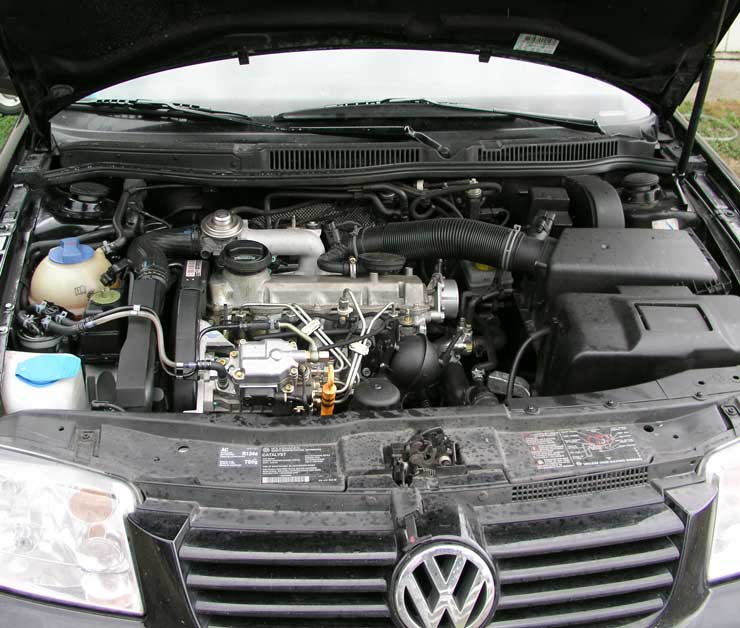
OK, so everyone knows the car in the foreground is a Ford GT40. Can you have a guess at the one in the right background is?
My dad went gaga when he saw it. He recognized it instantly… I was wondering if any of you guys do too.
goolsbee.org, serving useless content from an undisclosed location since 1997

OK, so everyone knows the car in the foreground is a Ford GT40. Can you have a guess at the one in the right background is?
My dad went gaga when he saw it. He recognized it instantly… I was wondering if any of you guys do too.

Above: The amazing 1.9 Liter, VW TDI engine. The thing that makes my Jetta go.
OK, so everyone knows I’m a cheapskate and make my own Diesel fuel from veggie oil. (yes Paul, I promise a diagram of the filtering setup soon!)
I also am a total lead foot and don’t drive very economically. I rarely drive the speed limit and frequently exceed it by a fair margin. I’m not an idiot, and I don’t speed where it would be dangerous to myself or others. I have only been *ticketed* for speeding twice in the past 10 years, so I must be good at avoiding speeding tickets (I have been stopped several times and warned though.) There was a blog post I saw linked off digg.com a few weeks back about avoiding speeding tickets that was partially wrong, and misleading in some aspects… perhaps I should write up a full post of my own. Anyway, this isn’t about speeding… in fact quite the contrary, it is about fuel economy. So even despite my lead foot and frequent runs at autobahn speeds, my car still averages 50 MPG. I find that amazing. It begs then how well would it do if I wasn’t such a pseudo-Schumi?
I once again drove half a tank (300 miles) in my VW Jetta TDI this past week or so, and when I topped it off tonight on my way home I was gobsmacked by the mileage I made. You see I spent the week driving verrrry carefully. This meant upshifting at 2000 RPMs on the tach, coasting down hills in neutral, coasting to stoplights and stop signs in neutral, (mostly) driving the speed limit, etc. I went 300 miles on 4.3 gallons of my veggie oil and Diesel fuel mixture. That is 69.767 miles to the gallon. That is US gallons for my overseas readers, which equals 0.832 Imperial gallons, or 3.78 liters.
69.7 MPG = 29.71 km/L
I could have managed 70 MPG if I hadn’t succumbed to temptation and NOT had a several mile long run @ 100 MPH a few nights ago. I ran an errand on Wednesday night that put me on a deserted divided highway at around 10 PM. I came off a stop light and onto the freeway doing my usual “shift @ 2000 rpm” routine, but once I realized I was alone I just kept accelerating to the mythical “ton” and rode along for several miles like that with a smile on my face. I did coast for quite a way after the ton-run to make ammends… in fact I was able to coast UP a big hill after that. 😉
My only issue with driving like this is that it is mind-numbingly boring, and lacks that je ne c’est quois… that essential Fahrvergügen I seek when behind the wheel. This is why I can never make it past half a tank! If I ran it all the way I’d die of boredom before I ran out of fuel!
So was this in some goofy anemic Hybrid filled with digital gizmos? Nope. It was in a low-tech car with an oil burning engine, albeit one running a very “green” fuel. I challenge any Hybrid or even electric car to go as far, as fast as a TDI equipped car. It just can’t be done. I could run from my home to Red Bluff, California (~700 miles) on a single tank of fuel, and do it in about 8 hours. Amazing. This car amazes me.

Stopped for speeding. Name the car behind me.
After years of decline, data centers are back
Finally. The press has caught onto our (pardon the pun) current reality. *
They are, as per usual in the press, wrong on the details. The industry has never been in “decline”, but it is in good shape at the moment.
Power is the name of the game, and we actually have it. Internap, at least in Seattle, does not. We are at 10% of our available capacity and we have the right amount of floor space to handle a fairly dense install. InterNap in contrast limits their customers at Fisher Plaza to half racks by limiting their power.
Back in the bad days of 2001-2003, we saw a small burst of growth as colo facilities in the Seattle market started closing. Exodus, Colo.com, Verio, Level 3, Qwest, Zama, etc were shutting down unprofitable datacenters. Some just vanished, others relocated their customers to California, or Colorado. We were able to pick up a lot of new business in colocation at the time, ironically because we were a small, local company with almost a decade of history… unlike a large, non-local company, which was brand new and burning a pile of VC cash. Suddenly the desire was for businesses doing the new-economy in an old-fashioned way – with revenue from customers, not investment from venture capital funds.
The one company that consistently won the larger business (multi-rack installs) away from us was InterNap. Prior to the new economy meltdown of 2001, digital.forest was a value-priced colocation facility. We were priced at a sustainable level, but still much lower than Exodus, or similar facilities. We had to be as we were small, and our facility was at that time, very second-tier. InterNap in contrast was in a brand-new, state-of-the-art facility in Seattle’s Fisher Plaza. What compounded the problem for us was that InterNap was losing money hand over fist, but were buoyed by cash from a pre-crash IPO. They had a huge facility to fill, and were practically giving it away. Their prices were unsustainable… insanely low. A full 50% below our pre-crash prices, sometimes even lower. We didn’t have a mountain of cash to burn, nor did we have thousands of square feet of empty datacenter, so we couldn’t match those prices and lost virtually every one of the larger bids we put out to InterNap.
A few years later, we moved into one of those “state-of-the-art” colocation facilities left behind by a failing “dotcom” and suddenly we find ourselves in a facility equal, if not better than, InterNap’s at Fisher Plaza. I’d argue the latter position as we have a landlord (Sabey) that truly understands our business model (they built most of these facilities for the now-mostly-gone Colo providers) and agreed to let us manage our own facility infrastructure. We maintain the HVAC and backup power systems directly, rather than second-hand via the landlord, as with Fisher. So as the datacenter economic landscape has been improving over the last few years** prices have once again started to rise and are just now reaching sustainable levels again. But, just as InterNap are going back to those clients they gave away space to back in the day to tell them about higher prices, they also can not provide them with any more power. I said it back in 2002, and I’ll say it again now: “I encourage my competitors to operate this way.”
Today’s savvy colocation customer expects to pay market rate for rack- or floor-space, but they also expect to have custom power solutions delivered to their racks. The industry standard of two 20 amp circuits per rack went out with the Pentium III. Until the computer hardware and chip industry can get their act together and get power consumption under control, today’s racks require 60 amps, or MORE.

Above: near maximum density before going to blade servers. A digital.forest client’s installation of 1u & 2u multi-cpu servers, plus 3U disk arrays of storage. This client has been growing at a “rack per quarter” rate for the past year. They’ll be moving into a cage in our new expanded space around the holidays.
We are finally in the position to turn the table on InterNap, as we have space, and more importantly, power & cooling capacity to spare, right as the market heat is approaching “boil”. For once, we are sitting on the right side of the supply/demand curve.
* I’m linking to the story in the PI, mostly because it is a local paper about a local company (well, USED to be local) in our industry. I first read it online in the New York Times, but they have that massively annoying “free registration system” and I don’t know how many of my readers are savvy enough to get through that with “bugmenot”… thankfully the Seattle PI picked it up.
** I’d say that the datacenter economy never really went down. If anything the growth of it has been a rock-steady linear graph since our beginnings in 1994. The only odd year was 1999, when it experienced a doubling, but every other year has seen roughly 50% growth, even the “bad” years of 2001-2002. What happened was that between 1998 and 2001 the industry overbuilt capacity. Everybody was investing in datacenters and as a result a classic over-supply, under-demand situation arose that artificially depressed the datacenter industry.

Taken in 2003, in the 65E, approaching Lake Pend’Oreille, Idaho. That’s me in the mirror.
–chuck

Super easy guesses as to all the cars in the pic… have at it!
In the spring, I entered some of my Jaguar photos in a contest sponsored by parts supplier SNG-Barratt. I liked the idea of the 65E earning some cash for parts, especially since my eBay quest for an air filter cannister has been fruitless – some guy named “George” has outbid me for every single one that has come up over the past YEAR. WTF? I give up George, you can have them all… every rusty cannister from now until eternity is yours. I’ll cash in my parts voucher for a “new” one from SNG.
As soon as I got the invite I burned a CD and mailed it off to the UK (The USPS has very good rates for overseas express mail) a week or so later I received an email from an Art Director there who praised my work and said that I was the entrant so far who “got” the idea of the contest, placing Jaguars in highly scenic or interesting shots. He had nothing to do with judging, but did want to send me a thanks. It felt great.
So here I get the big news in email yesterday and … they’ve misspelled my name! Oh well.

They also picked the “Miss January” shot.